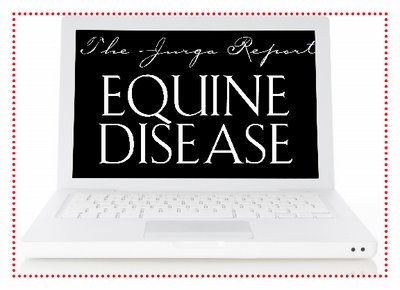CEM Alert in Canada: Semen From Infected Kentucky Stallions Crossed Border into Alberta and Ontario; Government Urges Stop to US Semen Import
- March 10, 2017
- ⎯ Fran Jurga
Here’s a notice from the Canadian government about the possibility of CEM-infected semen being used on Canadian mares. Canada, like the USA, is concerned about losing its CEM-free status for equine transport. This disease has many far-reaching implications for horse breeders, buyers, sellers, and international exhibitors and competitors. It also brings into focus the international scope and impact of horse breeding in North America. While the infection started with Quarter horses, the legal and governmental implecations would affect all breeds and sports.

OTTAWA, December 24, 2008 – The Canadian Food Inspection Agency (CFIA) has launched an investigation after confirming that horse semen was imported into Canada from a United States stallion subsequently determined to be infected with contagious equine metritis (CEM). There are no human health implications with this disease.
United States officials have confirmed that three stallions on a Kentucky farm tested positive for CEM. Shipments of frozen semen from one of these stallions were sent to Ontario and Alberta in the spring of 2008. CFIA and provincial animal health officials are currently tracing the shipments to identify potentially exposed animals. As a precaution, the CFIA will place these animals under quarantine until they have tested negative for CEM.
CEM is a highly contagious disease that affects the reproductive tract of horses. The disease can cause temporary infertility in mares. In most cases, CEM can be successfully treated with disinfectants and antibiotics. CEM is a reportable disease in Canada. This means that all suspected cases must be reported to the CFIA for immediate investigation by inspectors. There are international trade implications if a country loses its CEM-free status.
Until more information is available from the U.S., the CFIA is recommending that the equine industry and importers in Canada exercise caution and refrain from importing breeding horses, embryos and semen from the U.S.
CEM is primarily spread directly during natural breeding, but can also be transmitted during artificial insemination and through contaminated instruments and equipment, such as tail bandages, buckets, sponges and gloves. Therefore, horse owners and veterinarians should maintain strict hygiene when handling breeding mares and stallions to prevent infection.
Infected stallions tend to be the major source of infection, as they can harbor the disease for years without showing any clinical signs. The primary symptoms of infection in mares are short-term infertility and vaginal discharge, but some mares can also carry the disease without clinical signs. Any Canadian horse owners or veterinarians who suspect a horse under their care may be infected with CEM should immediately contact their local CFIA District office.
The CFIA will continue to work with provincial counterparts, affected producers and the equine industry in this response effort. Additional information will be provided as it becomes available.
More information about CEM is available on the CFIA Web site at www.inspection.gc.ca.





